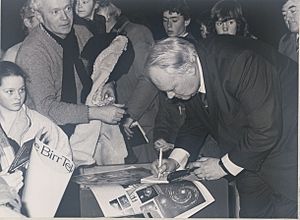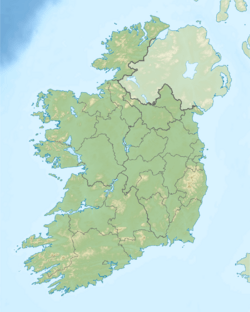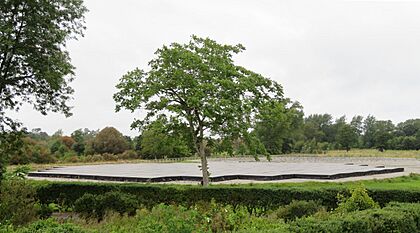Birr Castle facts for kids
Quick facts for kids Birr Castle |
|
|---|---|
| Caisleán Bhiorra | |
| Birr, County Offaly | |
 |
|
| Coordinates | 53°05′43″N 7°54′53″W / 53.09536°N 7.91476°W |
| Type | Castle |
| Site information | |
| Owner | Brendan Parsons, 7th Earl of Rosse |
| Open to the public |
Yes, the gardens and science centre are open all year round. The Castle interiors are open in the summer for tours. |
| Site history | |
| Built | 1170 |
Birr Castle (in Irish: Caisleán Bhiorra) is a big castle in the town of Birr, County Offaly, Ireland. It is the home of the 7th Earl of Rosse and his family. The castle itself is usually not open to everyone. However, its amazing grounds and gardens are open to the public. Here you can find a science museum, a café, and two very special telescopes. One was once the biggest in the world!
Contents
History of Birr Castle
There has been a castle on this spot since 1170. For many centuries, from the 1300s to the 1600s, the O'Carroll family ruled this area. It was known as "Ely O'Carroll".
In 1620, Sir Lawrence Parsons was given Birr Castle. He also received a large area of land. Parsons hired English builders to construct a new castle. They built it near the old gatehouse. They added strong towers on the sides. This gave the castle the shape it still has today.
Later, during the Irish Rebellion of 1641, William Parsons was trapped inside the castle. Catholic forces surrounded it for fifteen months. After this war, William's son, Laurence, made the castle look new again.
Another family member, Laurence Parsons, 2nd Earl of Rosse, also rebuilt parts of the castle. He made it taller and gave it a "Gothic" style in the early 1800s. His son, the 3rd Earl of Rosse, built the famous "Great Telescope" at Birr.
The Great Telescope
When it was finished in 1845, this telescope was the largest on Earth. It could gather more light and see further into space than any telescope before it. Because of this, Birr became a very important place for studying stars. People from all over the world came to visit the observatory. Famous visitors included Charles Babbage and Napoléon Eugène, Prince Imperial.
When the 3rd Earl died, his sons continued his scientific work. Lawrence Parsons, 4th Earl of Rosse is known for measuring the heat of the moon. But after he died in 1908, the telescope slowly fell apart. Its main mirror was moved to the Science Museum in London. Around 1914, the metal parts of the telescope were melted down. They were used to make things for the First World War.
The telescope was later restored in the late 1990s. It looks much like it did when it was first built.
In 2025, three Irish observatories were added to a special list. This list is called the World Heritage Tentative List. It is the first step towards becoming a UNESCO World Heritage Site. These observatories are Dunsink Observatory, Birr Castle, and Armagh Observatory.
Exploring the Castle Grounds
Location and Access
The castle grounds, also called the "demesne," are south of Birr town centre. The main entrance for visitors is through a courtyard. You cannot go directly into the castle from here. The castle faces into the grounds. A bridge over a dry moat separates the castle from the wider parkland.
The entrance courtyard has the Science Centre, a café, and a shop. The family who lives in the castle has their own private entrance.
Birr's main river, the River Camcor, flows through the grounds. It goes into a pond and then into the Little Brosna River. This river marks the border between County Offaly and County Tipperary. The grounds are open to the public for a fee.
Ireland's Historic Science Centre
The castle grounds are also home to Ireland's Historic Science Centre. This museum tells the story of Ireland's famous scientists. It shows their work in astronomy and botany. The museum is in a courtyard. It has displays about space, engineering, photography, and plants.
Laurence Parsons, 4th Earl of Rosse, and his mother, Mary Parsons, Countess of Rosse, were excellent photographers. Her darkroom is on display in the museum. It is thought to be the oldest surviving darkroom in the world.
Café and Shop
The Castle Courtyard Café and a small shop are in the same courtyard. They are right next to the Science Centre.
Parklands and Gardens
The castle grounds have the oldest wrought-iron bridge in Ireland. It was built in 1820. There was also an early power station near the bridge. It used water to make electricity.
The walled gardens have Box Hedges that are over 300 years old. According to The Guinness Book of Records, these are the tallest hedges in the world.
In 2014, a special tree from Birr Castle was entered into a European contest. It was a Grey Poplar tree. Sadly, it was blown down in a storm that same year.
Giants' Grove
The grounds also have a special area called Giants' Grove. Here, you can find giant sequoia redwood trees from California. These trees were planted as part of a project with the estate and Crann, a tree organization.
Astronomy at Birr Castle

The "Great Telescope" – The Leviathan
A very important part of the castle grounds is the "Great Telescope." It is also called the Leviathan of Parsonstown or The Rosse Telescope. It is an astronomical telescope with a huge 183-centimetre (72-inch) mirror. It was finished in 1845. It was used for many years until the early 1900s.
Its record size was not beaten until 1917. That's when the 100-inch (2.5-meter) Hooker Telescope was built in America. The Leviathan was taken apart in 1914. But its structure was rebuilt and the telescope put back together in the 1990s. Visitors can now see it. Sometimes, they even show how it moves.
Modern Radio Astronomy
Trinity College Dublin rents land on the Birr Castle grounds. Here, they run the Rosse Observatory. This includes the Irish station of the LOFAR network, called I-LOFAR. There are also some smaller radio telescopes. I-LOFAR is run by a group of Irish schools and universities. This means that scientific research is happening at Birr again, after a break of about 100 years.
These astronomy projects are located near the Little Brosna River. In 2010, a scientist named Peter T. Gallagher visited Birr Castle. He was looking for quiet places for radio telescopes. He met Lord Rosse, and they agreed to use an old sheep yard. This led to the Rosse Solar-Terrestrial Observatory. It officially opened in 2014. Its antennas pick up signals from the sun. The old sheep building was turned into a control room.
The team then started building the I-LOFAR radio telescope station. This station is part of a large network across Europe. It was mostly built in 2016. Its first official use was on July 27, 2017. It was built in fields between the Camcor and Little Brosna Rivers. The I-LOFAR telescope has many antennas. It has 192 antennas, each with two parts, making a total of 384 antennas. It is the most western station in the LOFAR network.
In 2018, the I-LOFAR telescope made an exciting discovery. It observed a billion-year-old red-dwarf star called CN Leo. This star is almost 75 trillion kilometres away! There is a special viewing point for visitors to see the telescope structure.
See also
 In Spanish: Castillo de Birr para niños
In Spanish: Castillo de Birr para niños






